
When Pee-wee's Playhouse debuted on September 13th, 1986, Saturday morning children's programming was on a downward slide, with ratings falling and the quality of the content increasingly... well, awful.
"It was an era of really bad Saturday morning television," said art director and design historian Norman Hathaway, who later worked on the design of some of the Pee-wee merchandise. "Probably the worst in television history... about 90 percent of it was crappy animation with the purpose of selling a toy."
And while the huge success of Pee-wee's Playhouse would later translate into the selling of plenty of product, the show was very different; it was in part a throwback to an earlier generation of adult-hosted kiddie shows—starring comedians like Sandy Becker, Pinky Lee, Soupy Sales, Sonny Fox, Uncle Floyd and many others—with a strong mixture of punk rock, psychedelia, surrealism, trash culture, retro-futurism, Dada and any other avant-garde term you may choose to apply. It was endearing, childish, funny and stupid.

As Phil Trumbo, animation director for the first season of the Playhouse, told the Richmond, VA alternative news outlet Style Weekly earlier this month: "The thing that was cool for all of us was to feel like, wow, we're going to reach a mainstream Saturday morning audience. We were influenced as kids by the TV shows that we watched, and we got to be part of that."
The show's star, Paul Reubens, had already portrayed Pee-wee Herman on stage and film; he would remain associated with the character for more than 40 years. He died, unexpectedly to most, at the age of 70, on July 30, 2023, after several years of quietly battling cancer. Following the announcement of his death, the outpouring of tributes on social media and in traditional television and news showed that Reubens' wide-ranging impact on popular culture was visual, visceral and prescient. With its design aesthetic guided by artist/cartoonist Gary Panter, Pee-wee's Playhouse didn't just look radically different from any other mainstream program; the show's thematic core—one based on inclusion, acceptance and anarchy—was radical as well, especially amid the cultural polarization of its age. In a 2016 profile of Reubens in the New York Times Magazine, Jonah Weiner wrote: "Arriving in the thick of the Reagan '80s, Playhouse offered a funhouse-mirror vision of the Eisenhower-era United States that Reubens grew up in—its excess, its materialism, its hypocrisy, its racism, its hairstyles—with an added slathering of Los Angeles punk.... Reubens didn't attack '50s conventions, though, so much as revise and exaggerate them."
"I saw it as very Norman Rockwell," Reubens told the Times, "but it was my Norman Rockwell version of the '50s, which was more all-inclusive.... That came out of growing up in Florida under segregation. I felt really good about that."
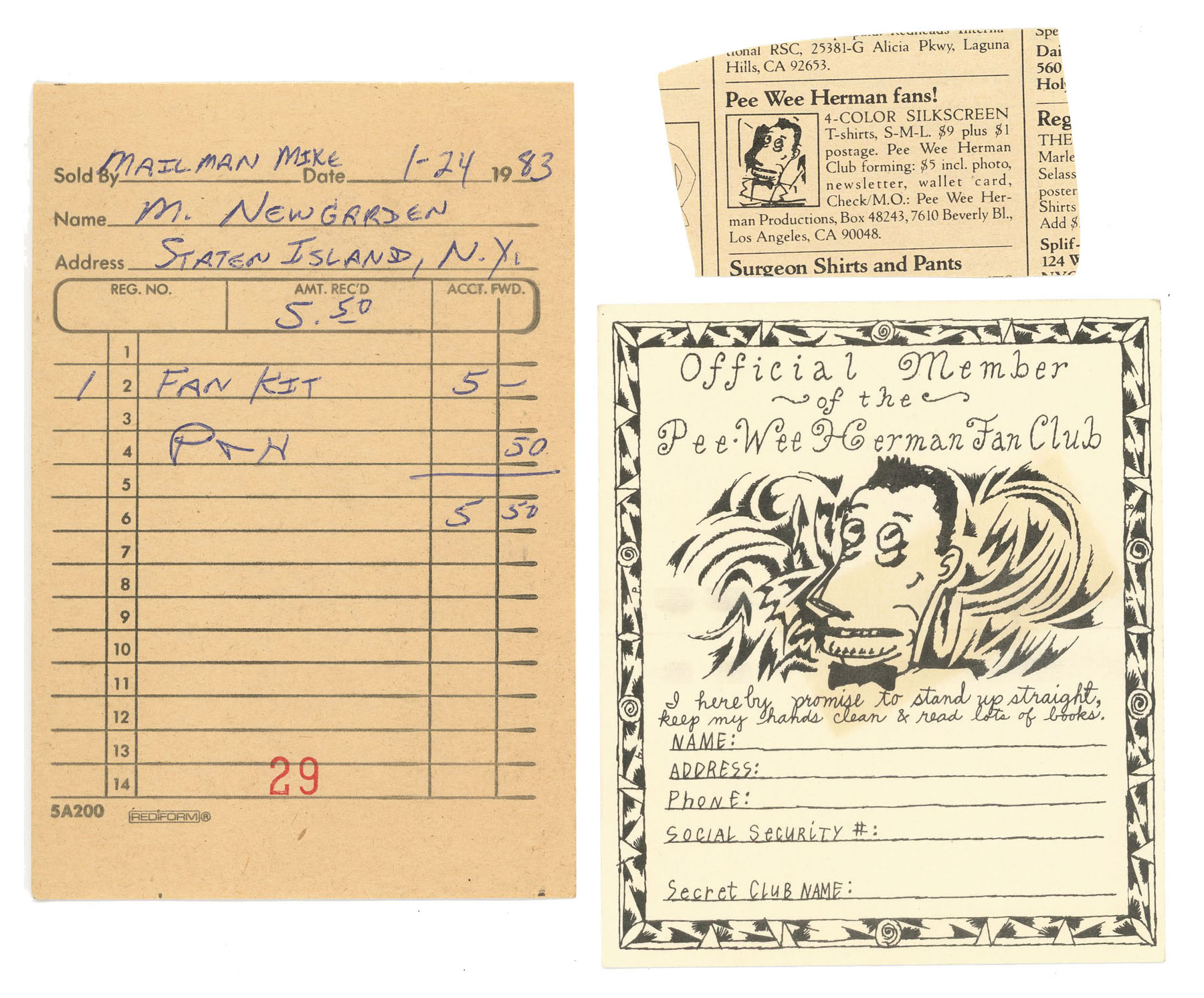
The Design Team

The core designers responsible for creating the look of Pee-wee's Playhouse were Panter, Wayne White and Ric Heitzman, artists who all spent time in the world of comics. Panter had been involved with Pee-wee since the early days, when Reubens performed on stage.
"I designed the Pee-wee stage production that became the Roxy [Theatre] show [in Los Angeles] and that ran for maybe a year and that was filmed for [a 1981 HBO special], and wrote a script for [the film] Pee-wee's Big Adventure, which didn't get made, and then the TV show did," Panter said in a 2003 interview with The Comics Journal. "I got to design the TV show partly by accident... the show got sold to Broadcast Arts, a production company in New York. It was accidental that I had just moved to New York, that I was here helped."
Pee-wee's Big Adventure, released to theaters with a different script in 1985, marked the feature film debut of director Tim Burton and one of the first film scores by Danny Elfman, then still a member of the music group Oingo Boingo. The movie was a hit, grossing $40 million domestically. The television show followed the next year.
As Pee-wee's world grew, other talented artists joined with Panter in bringing Reubens' vision of beautiful chaos to life on an even larger scale. Following Reubens' death, I reached out to Panter, White and Heitzman to share memories about Reubens and his world(s), as well as some of the artists responsible for creating the remarkable merchandise produced in the wake of the Pee-wee phenomenon.
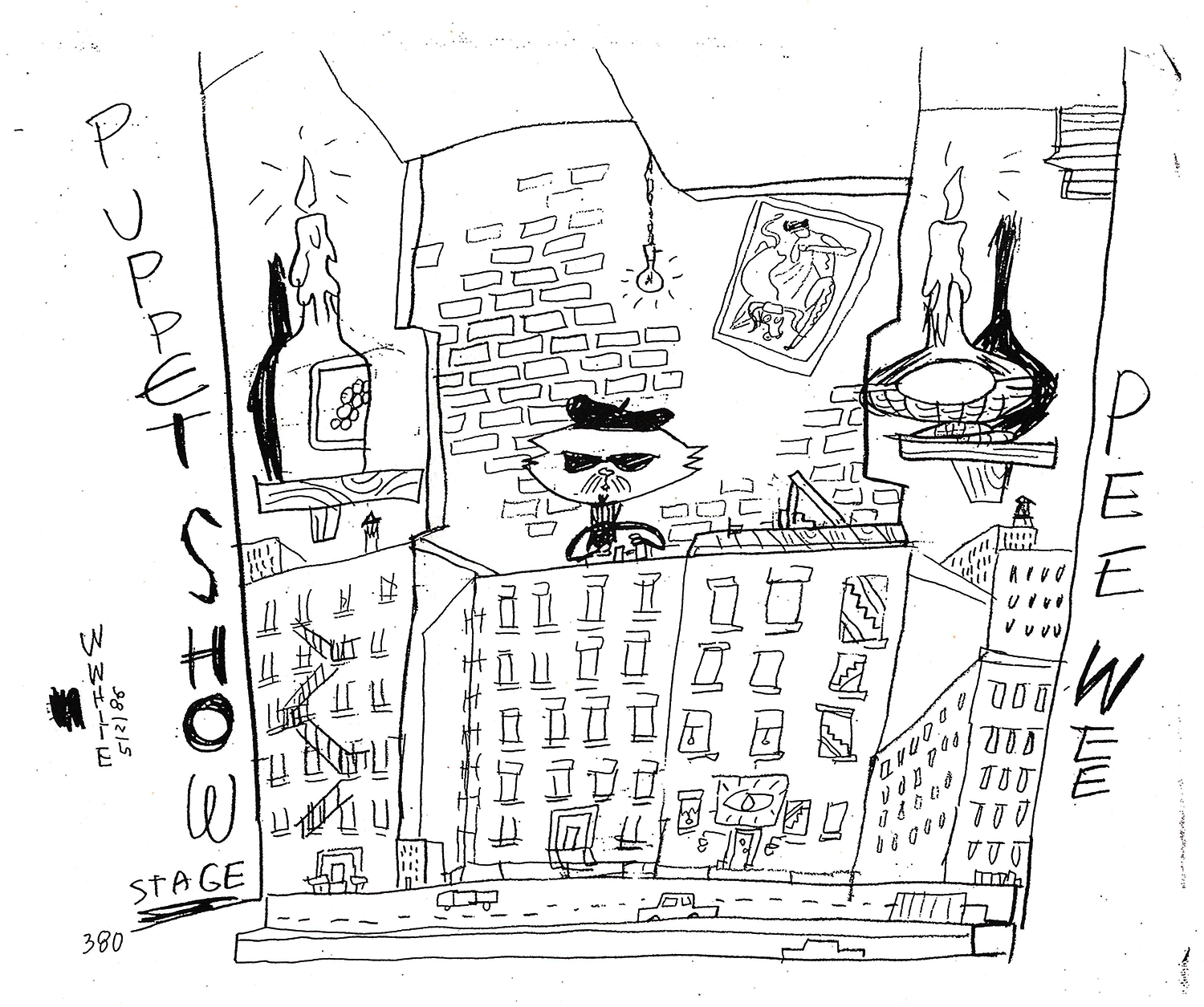
"The power of the Playhouse was that it was created by artists, not TV design professionals," White said. "We were all downtown NYC painters, cartoonists and sculptors doing a TV show for the first time. Paul was a conceptual performance artist himself. We snuck an art project onto network television and it stood out like a beautiful sore thumb."
"Pee-wee's Playhouse was a show waiting to be born since the '60s," Panter recalled. "Paul Reubens' genius and ambition were the catalyst and driver of that dream finally emerging into visibility."
Heitzman: "I remember feeling giddy most of time we were in production, not from the legendary amount of pot consumed, but from anticipation that we were going to blow people's minds. We were excited and felt lucky to have an audience for our artwork."
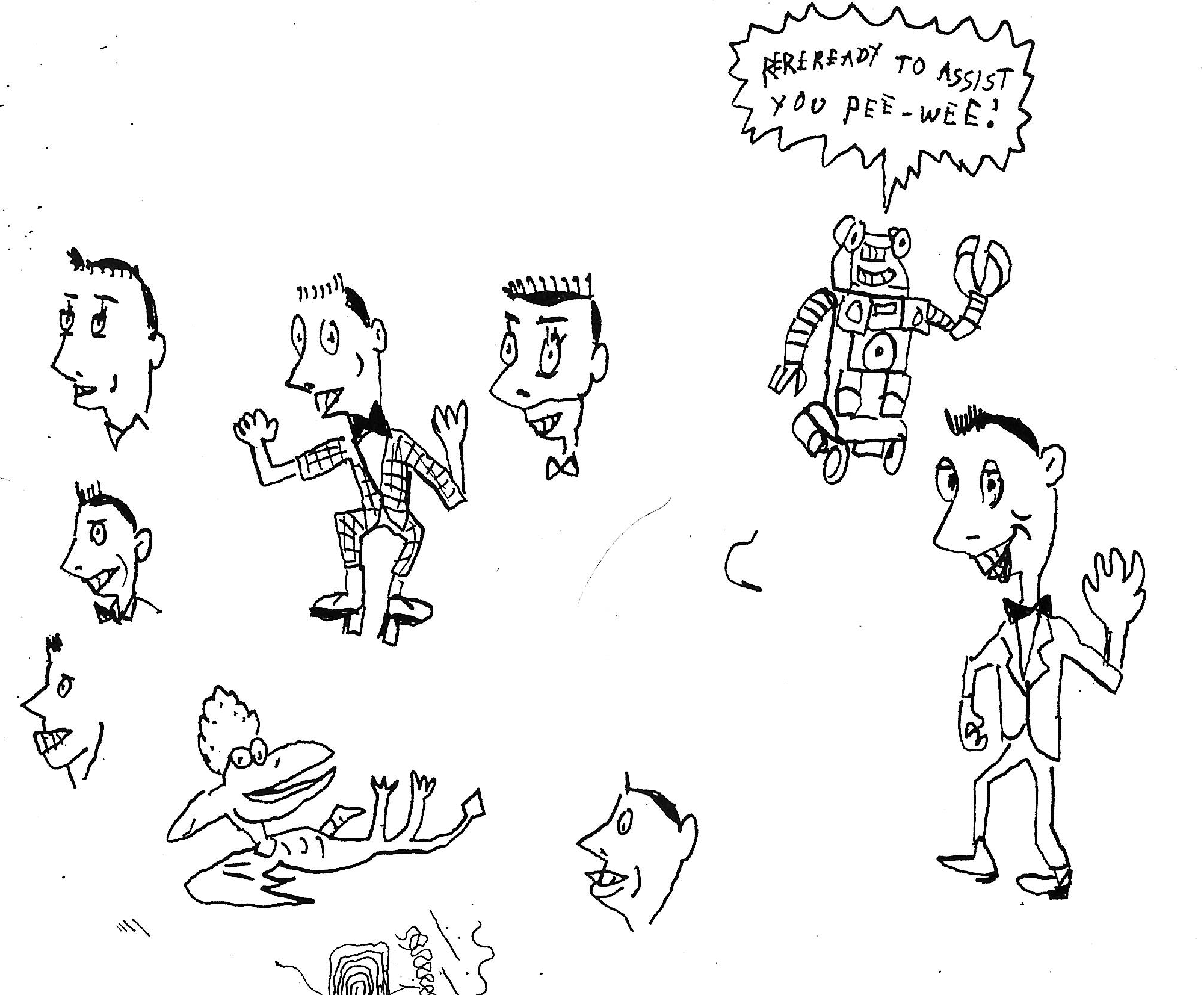
"The group of people that we would up with, who created the show, were like a family," Reubens said in Beauty is Embarrassing, a 2012 documentary about White, who, along with Heitzman, also did voices and puppeteering for the show. "They were always in their little sketchbooks or journals, sketching up a storm... I think those guys were like the brothers they never had or something... we were a group of people that felt like we were making art, doing something serious and important. If you're an artist, it doesn't get any better than that."

Building Pee-wee's Playhouse
The show was unlike anything else. Wall Street Journal correspondent John Jurgensen, in an attempt to describe it, wrote: "As MTV was to cable and The Simpsons would soon be to prime-time, Pee-wee's Playhouse was a disrupter of the TV domain for kids. The show's psychedelic absurdism also attracted an audience of teens, college students and savvy parents of the show's target viewers. With his wild remix of the kids' shows that he grew up with as a baby boomer, Reubens put a stamp on Generation X."
So, how did all of this start? Panter, in the massive slip box monograph of his career, Gary Panter (PictureBox, 2008), describes what set the wheels in motion: "Around 1979 I was approached by Paul Reubens to do a poster for a stage show that was an ode to old TV kid shows. He had seen my work around L.A., but I didn't know who Pee-wee Herman was, so I went and saw his act and really liked him. He had studied performance art at CalArts. His sensibilities were similar to mine and related to what Ric Heitzman, Jay Cotton, and I had done in Apeweek [a performance group Panter co-founded in 1975]. All three of us ended up working on the show. I told Paul that I would be happy to to do the poster and design the sets and puppets. So we started the stage show at the Groundling Theater, an improvisational theater on Melrose Avenue. Then we moved to the Roxy Theater and played there for six months in front of two or three hundred people a night. The show was becoming famous, and this led to HBO wanting to do a TV special. So HBO came in and filmed the stage show, we did some post-production work, and that was it."
As for the later Pee-wee's Playhouse, below is a series of testimonials from those who were there, and some who were watching, in their own words.
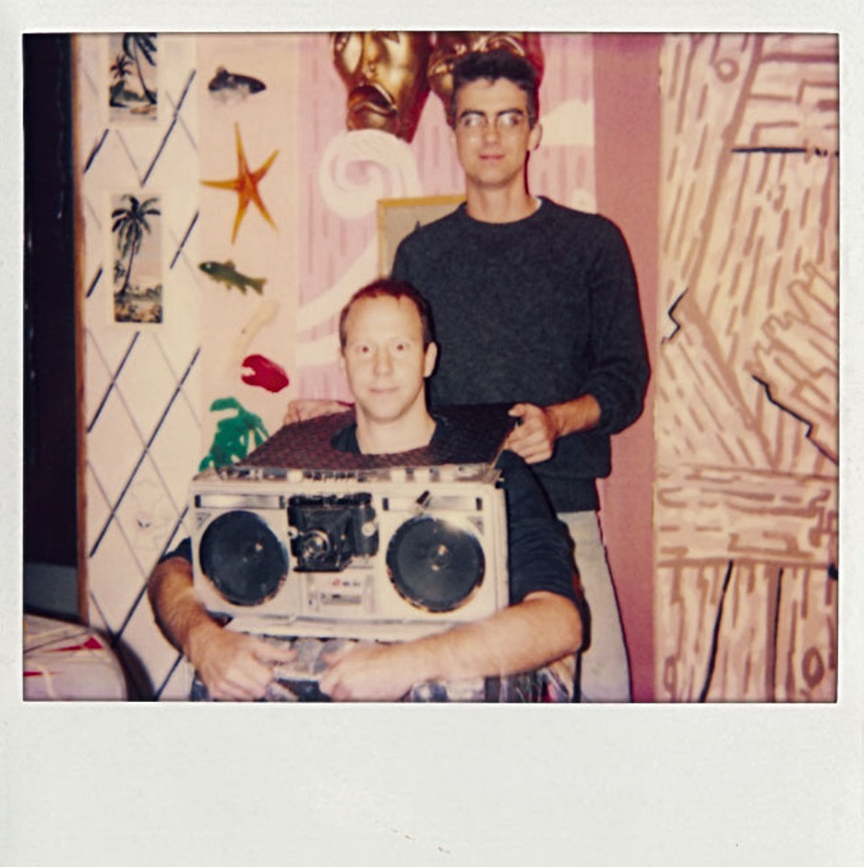
Ric Heitzman
(Pee-wee's Playhouse designer/actor/puppeteer)
Since college, Gary and I had a history of working together in a performance art band, Apeweek, along with Jay Cotton (who composed and performed music for Paul Reubens). Apeweek was also a short-lived radio program on a Dallas public radio station in the mid 1970s. Additionally we performed live shows that were a mix of music, art, comedy, and puppetry around Texas. Much like the Residents, we performed in costumes.
I was involved in Pee-wee's Playhouse on CBS TV from early on. In Spring 1986 I had been working in Manhattan as a freelance illustrator, cartoonist and animation designer.
Wayne was also in NYC, and we were aware of each other because we each published comics and gag cartoons in underground & national publications. Gary was living in LA.

The role of the production company Broadcast Arts in NYC was to develop a creative team to design and art direct the Playhouse. Gary had called me and asked if I would go into Broadcast Arts and "audition" for a role on the show. It was all very hush-hush. Gary had intended for me to design the animation necessary for the series. Usually, freelancers show a portfolio and are hired based on one's previous work, so "auditioning" was an odd request. I had the most experience as an animator of the people working on the series.
At Broadcast Arts, the receptionist at that time, Rob Zombie, escorted me into a small room. I was given a handful of BIC pens and a stack of copy paper by Prudence Fenton, the show's soon-to-be producer. Her instructions to me were to imagine the character Pee-wee Herman in his playhouse that existed in its own world. I drew 20 drawings in about 30 minutes with no script or reference. Prudence faxed those drawings to Paul in LA and asked me to wait. In approximately 15 minutes, Paul called back and told Prudence to hire me. Several of the items that I drew that day were integrated into the show's scripts: the video picture phone booth, and his scooter among them. I was no longer just relegated to designing animation, I was designing puppets and props too. Mr. Window, the Flowers, the Fish and the Ants were my specific designs. I also did many co-designs with both Gary and Wayne. We were tasked with over a thousand designs to accomplish in six weeks, and there was much overlap in a situation like that. We all designed patterns and sections of the playhouse walls. Gary's job was to make it all work together.
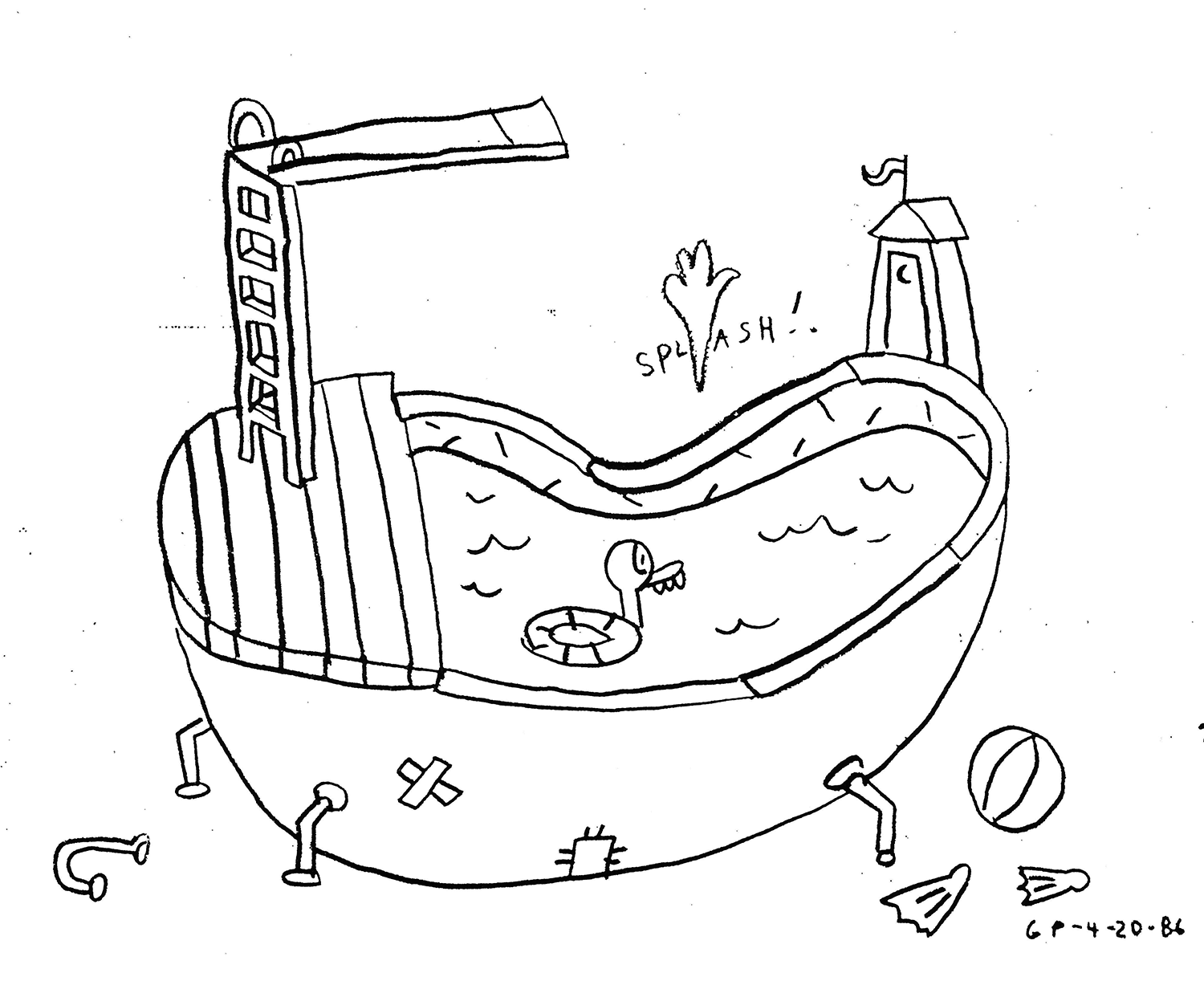
In NYC, before we began drawing, Paul, Gary, Wayne and I met and discussed concepts for the show. The over-arching idea for the life of the playhouse was to animate or puppet as many objects as possible within the playhouse to give it a surreal, childlike life that would be a modern take on an old Fleischer Brothers cartoon, combined with a folk art and a kitsch Pee-wee aesthetic.
In 1986, first season, Gary, Wayne and I spent the first few weeks holed up in a private office within Broadcast Arts getting scripts faxed to us, reading and breaking down the scripts for visuals ideas, character designs, etc. I wanted there to be every kind of animation: stop-motion, computer, effects... whatever was possible to translate the character of Pee-wee into.
Broadcast Arts had a very dedicated and talented staff of directors and animators, as well as film equipment available to work on the show; they were all integrated into the Pee-wee animation production staff.
One day over lunch, Paul was reviewing our puppet designs when he asked Wayne and I if we had ever thought of voices while we were drawing the characters. From the restaurant booth, we each performed various voices for the characters we had drawn. Paul seemed immediately charmed by our takes on the characters and asked us both if we were interested in doing the voices and puppets for the show.
I was cast to initially do Cool Cat in the Puppetland band, Mr. Window, one of the three flowers, Fish Number Two, the Salesman and Conky the robot. I puppeteered Pterri most of the time.
I shared the Conky role with Greg Harrison the first season and with Kevin Carlson the following seasons. We also traded roles depending on who did what voice. We all performed live with the live action actors, which included singing.
During the live action shooting, I did double duty as a puppeteer and an animation designer/director. I also did a number of voices for the dinosaurs, the ants and a number of miscellaneous characters throughout the seasons. Once, I portrayed Benjamin Franklin on the video picture phone.
It was a unique moment in my life when all things aligned. I had a hand in so many aspects of the overall production and worked with people that I continued to work with for years. Who would have imagined a Saturday morning children’s show with the likes of Laurence Fishburne, S. Epatha Merkerson, Lynne Stewart and a young Natasha Lyonne?
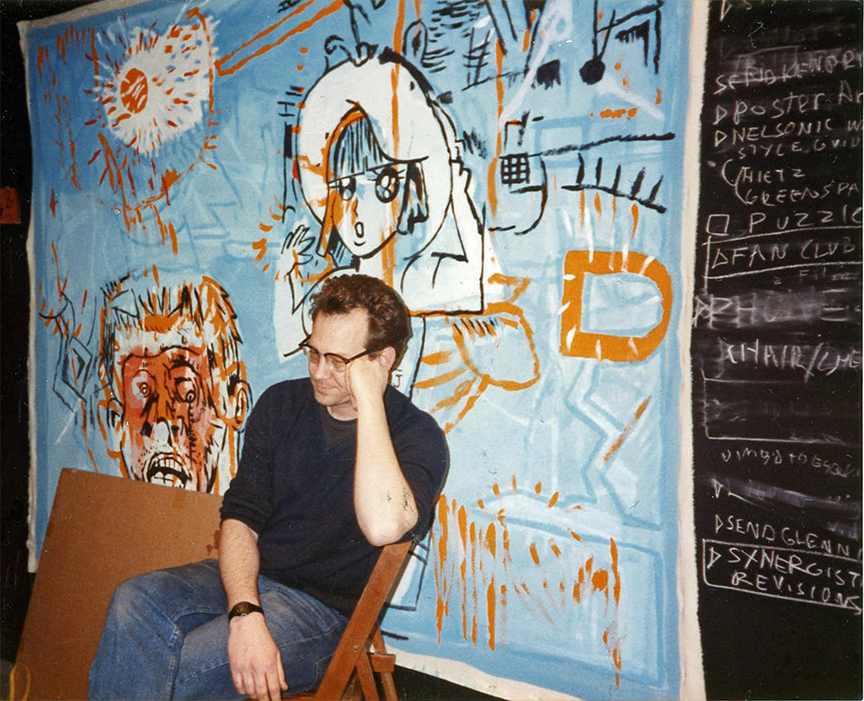
Gary Panter
(Pee-wee design guru)
There were many social and aesthetic issues imbedded in the Playhouse and Paul's work that also found their source in '60s liberation movements and explorations in art, music, illustration and comics. Gender identity, the explosion of color in the '60s following the drab '50s, inclusiveness, plurality, experimentalism - all issues that continue to evolve in modes of expression and struggle today. Paul's passing should be a reminder of his project's social relevance, and that is reflected I think in the degree of mourning for him and his character being expressed now.
Paul was very funny and very serious. He studied at CalArts and considered himself a concept artist in company of Ernie Kovacs and Andy Kaufman. Paul's character reminded me most of Eddie Cantor, though we never discussed that in depth even though we spent a lot of time together.
The Pee-wee show was a manifold for so many talented artists, actors, musicians, designers and identities. I think all of us that worked on the show finally had a say in the mood of the culture, much like Matt Groening accomplished with The Simpsons, or Frank Zappa manifested with his hybridic music and social critique.

Wayne White
(Pee-wee's Playhouse designer/actor/puppeteer)
At first I tiptoed around this dark, low-voiced actor who was nothing like his brilliant creation, Pee-wee Herman. I was a struggling cartoonist and illustrator in Manhattan who did house party puppet shows on the side. I sorta knew Gary Panter and I had a few ideas about how puppets could be cool again and not the Muppet clones that dominated the airwaves. So I did some drawings, and the mysterious sunglassed Paul liked them! It was an incredible validation that I’m still running on to this day. I kept drawing and getting the thumbs up 'till one day Paul took our little artist gang to lunch at one of those noisy '50s themed diners that were raging in the '80s.
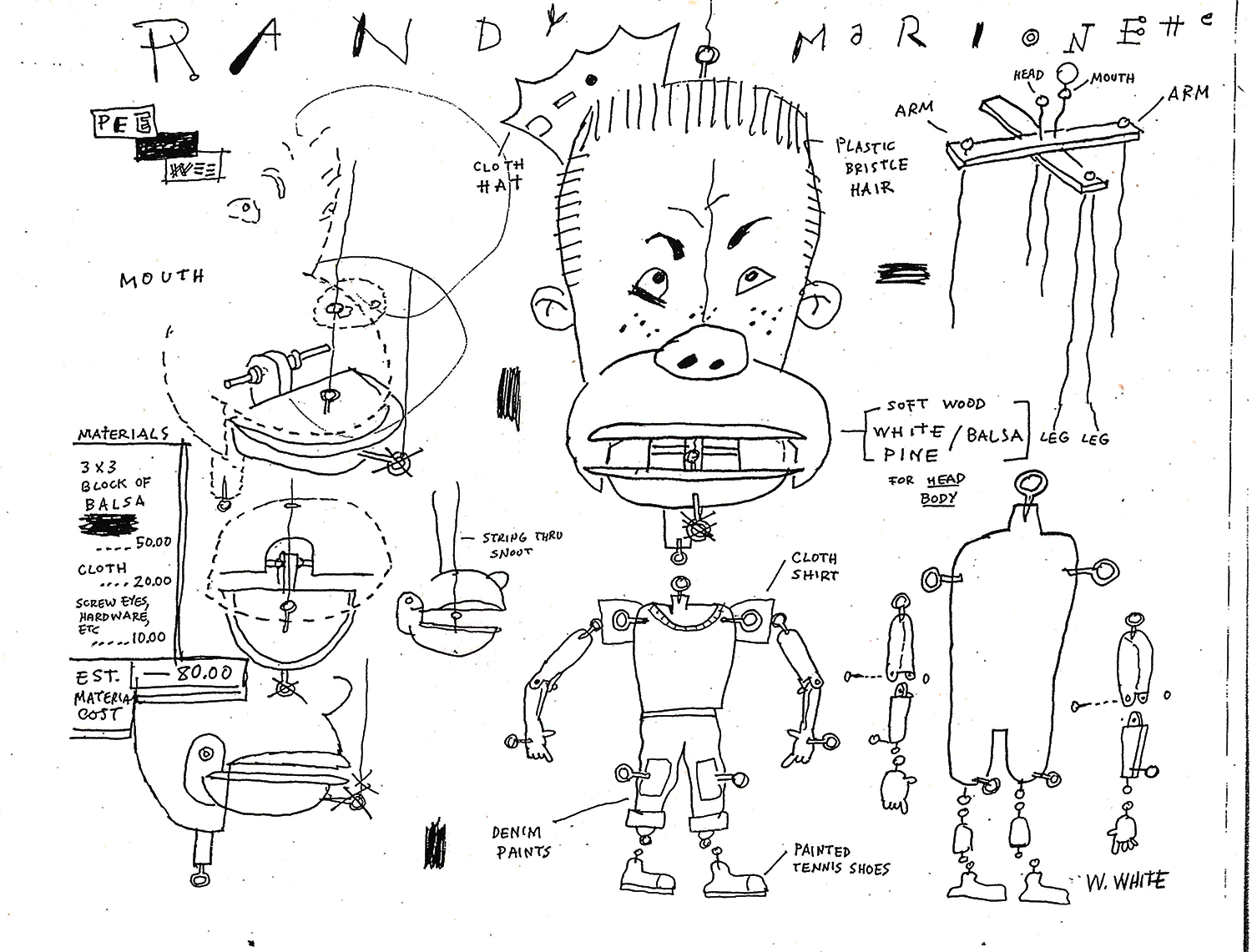
"So let me hear what this Randy puppet sounds like," he says.
Whu?! You want me to be a performer too?! I tried out for Randy and Dirty Dog in the booth that day as the Big Bopper and the Coasters blared in the background. And I got the parts. Bam! In a month I went from High Times magazine cartoonist to highly paid SAG performer on CBS. That was Paul. He was willing to take a chance on unproven, hungry types like myself.

Kaz
(designer of Pee-wee merchandise for Colorforms, the Topps Company and others)
The first Pee-wee Herman show I saw was the one HBO shot at the Roxy in LA [in 1981]. I believe I saw a bootleg video, since I didn't have cable TV back in my starving cartoonist days. So I can't remember what year I saw it. Of course I totally loved it. In 1982 or so, Pee-wee started to appear on Late Night with David Letterman, and I caught all those appearances as well as seeing his nightclub act in NYC. His nightclub act was him being silly and showing us his toys like he did on Letterman. He went to every table asking our names and then adding "O" on the end. "From now on, your name is Kaz-O." I saw Pee-wee's Big Adventure more than once at the movies. When Wayne White and Gary Panter (my colleagues from RAW magazine) began designing and working on the first season of Pee-wee's Playhouse in NYC, I was totally jealous. But of course Gary and Wayne were much more artistically advanced than me (and they still are)! So I was mostly excited to see what they would come up with - and the show totally knocked me out!
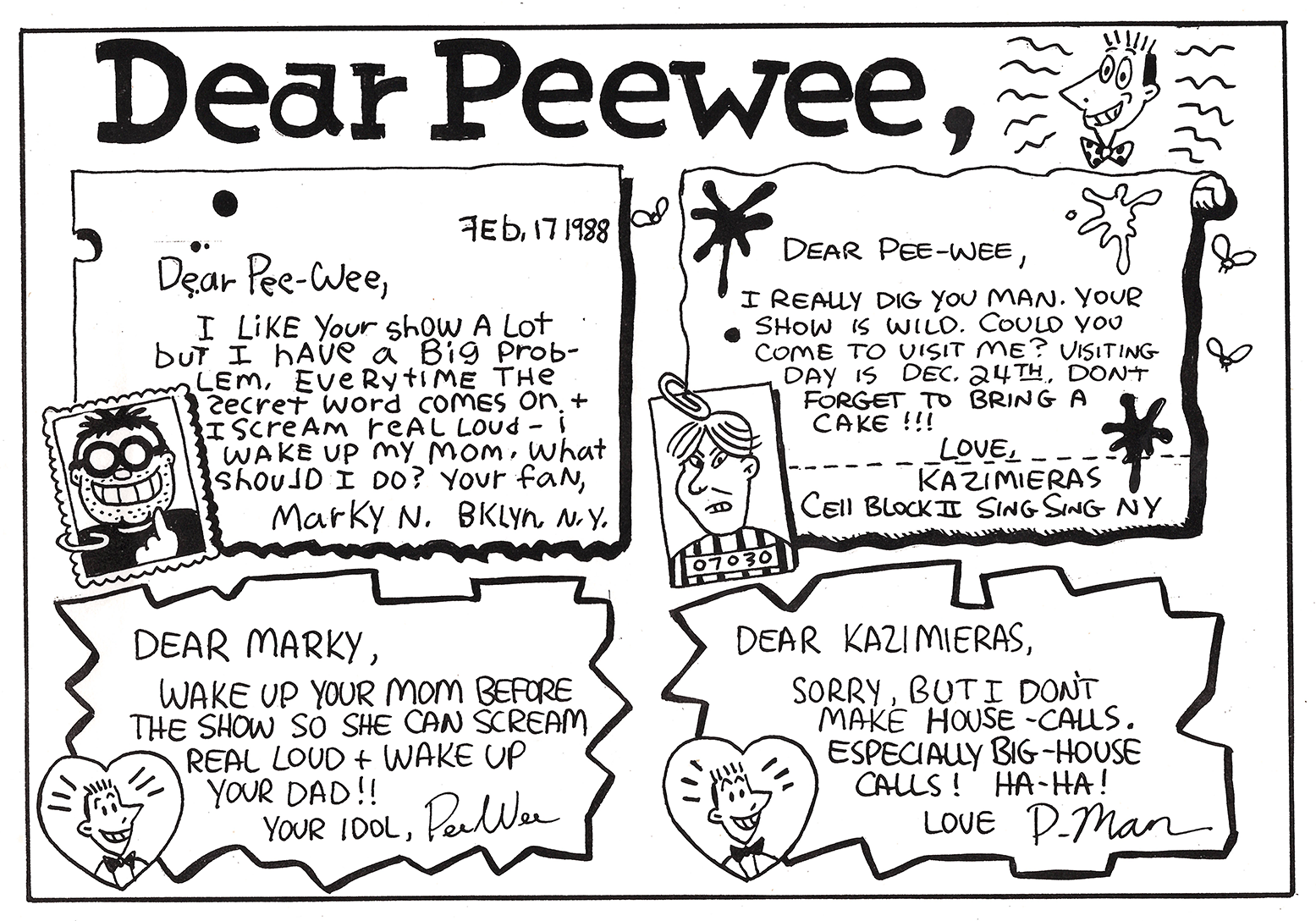
Mark Newgarden
(designer of Pee-wee merchandise for the Topps Company, JCPenney and others)
I first met Paul Reubens in full Pee-wee drag at the original Broadcast Arts Playhouse set on Broadway, a few blocks below Cooper Square in the summer of 1986. I think Wayne White, a friend from the NYC comics scene, made the introductions that day, but I was also friendly with his fellow Puppetland cast members Ric Heitzman (Mr. Window, Cool Cat) and Alison Mork (Chairry the chair, Chickie Baby). And of course, Gary Panter, who worked closely with Paul and who embodied the entire Playhouse aesthetic, had been in NYC for awhile. Stephen Kroninger and I would drop in to visit now and again, during their interminable waits between shots. I mostly remember the intense summer heat and the tubular Rube Goldberg air conditioning system that was set up outside the building to keep the Pee-wee cast fresh and perspiration-free. That day, Paul looked like he had just stepped out of a Carvel freezer unit. He greeted us in character and insulted us immediately. I was not disappointed.
***
Working with Paul Reubens

Wayne White
It's strange to be plucked from obscurity and enter into a day to day relationship with a famous person. And Paul Reubens was very famous in 1986... As I said, Paul was an artist. The real thing. He intuitively understood the studio process. He didn't settle for received thought. He had enough star power to champion mutts like myself. He was friends with Dolly Parton and Doris Duke. He wore tacky sport shirts unironically. He was vulnerable about idiots who didn't get the commedia dell'arte genius of the Pee-wee. He was a paranoid diva. He loved animals. He would call you on your birthday. He screamed out joy and it echoed everywhere and changed the world.

Ric Heitzman
Designing with Paul was a singular joy. We all felt we were on the same page.
The three of us would meet with him at the end of 12-hour days for Paul to review stacks of drawings and animation with us. His feedback was open and very quick. Paul reviewed everything and understood how much he was asking and was very helpful in keeping the production moving.

Paul was much more of a chameleon than Pee-wee would allow. Paul could be a devilish creature. Sometimes Paul would be in a Robin Williams-ish mode, riffing on everything from your shoes to a newspaper headline. He could be as cutting as he was courteous.
My memories of the show are very personal. Through the opportunity that Paul and Gary gave me, I was able to advance my creativity in ways I couldn't have anticipated. For example, ad-libbing with Phil Hartman and Lynne Stewart off camera between takes was an intense exercise with master comics. Phil would slip into scenes from famous films. If I was familiar with the scene, I would jump in with a supporting role. Phil was very generous with me and encouraged me to perform more as a comic.
In the very first live action shot of the series, Wayne and I had been awake for at least 30 hours finishing the puppets and making last-minute changes to art on the set. The assistant director had set up the opening shot of the Puppetland band: Dirty Dog (Wayne), Chicky Baby (Alison Mork), and me, Cool Cat. Scripts were handed out. We were to sing the Opening! The cameraman leans in and says to us, "Remember, only eight million people will be watching and you are the first thing that they will see, so break-a-leg!" I was in heaven. I had storyboarded this very idea just days before.

A surreal memory I have of a Playhouse moment was not scripted for the series. One day on the set, Paul said to Wayne and I that he had a surprise for us that afternoon.
After lunch, the set was closed to all but Paul, Alison, Wayne and I. Paul went to open the stage door and in walked Dolly Parton. Many famous people, Little Richard, Magic Johnson and Grace Jones had come to the set, but Dolly was a charmer. She was open and was very complementary of the set design. Then she asked us if we wanted to sing a song.
I remember a Hank Williams song was chosen. We all knew the words. We sang a song accompanying Dolly and Paul. I was singing with Dolly Parton as both Mr. Window and Cool Cat. When we finished, Dolly smiled and said, "That'll work!" We all performed in character, on the Dolly Parton variety show [Dolly, aired September 27, 1987]. I never anticipated singing as a window with Dolly Parton on television… that was unusual.
Gary Panter
I had a lot of fun with Paul, but as will happen with friends, especially that work on complex projects together, we didn't always agree. Things drove us apart and we didn't speak for many years over personal differences. We were involved in many attempts at projects that failed to materialize. There could have been many more amazing products from Paul if merchandisers had listened to him closer.
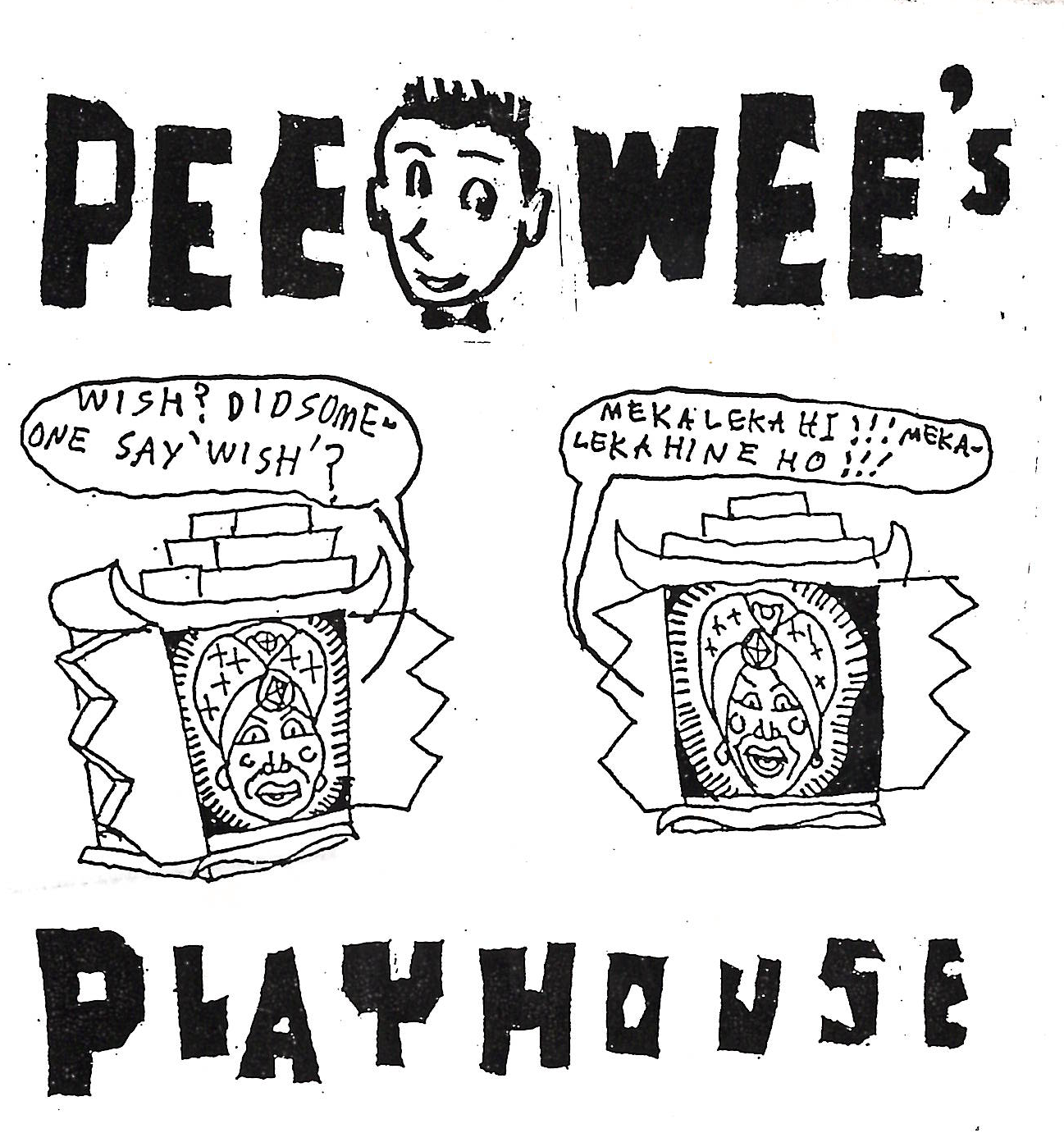
I loved Paul even after we stopped talking, and I consider him a genius at what he did and in what he wrought in steering the psyche of Americans ongoing.
Ultimately, it was Paul Reubens' and Pee-wee's "Playhouse," not mine.

NEXT TIME
In part two, we will look at the many consumer products created for the Pee-wee Herman empire, which included work by artists and cartoonists Gary Panter, Mark Newgarden, Kaz, Charles Burns, Richard McGuire, J. D. King, Stephen Kroninger and many others. There will be a lot of never-before-seen artwork. The 1992 "biographical" comic book (below) about Paul Reubens that appeared following his arrest at a Florida adult theater will also be revisited.
* * *









